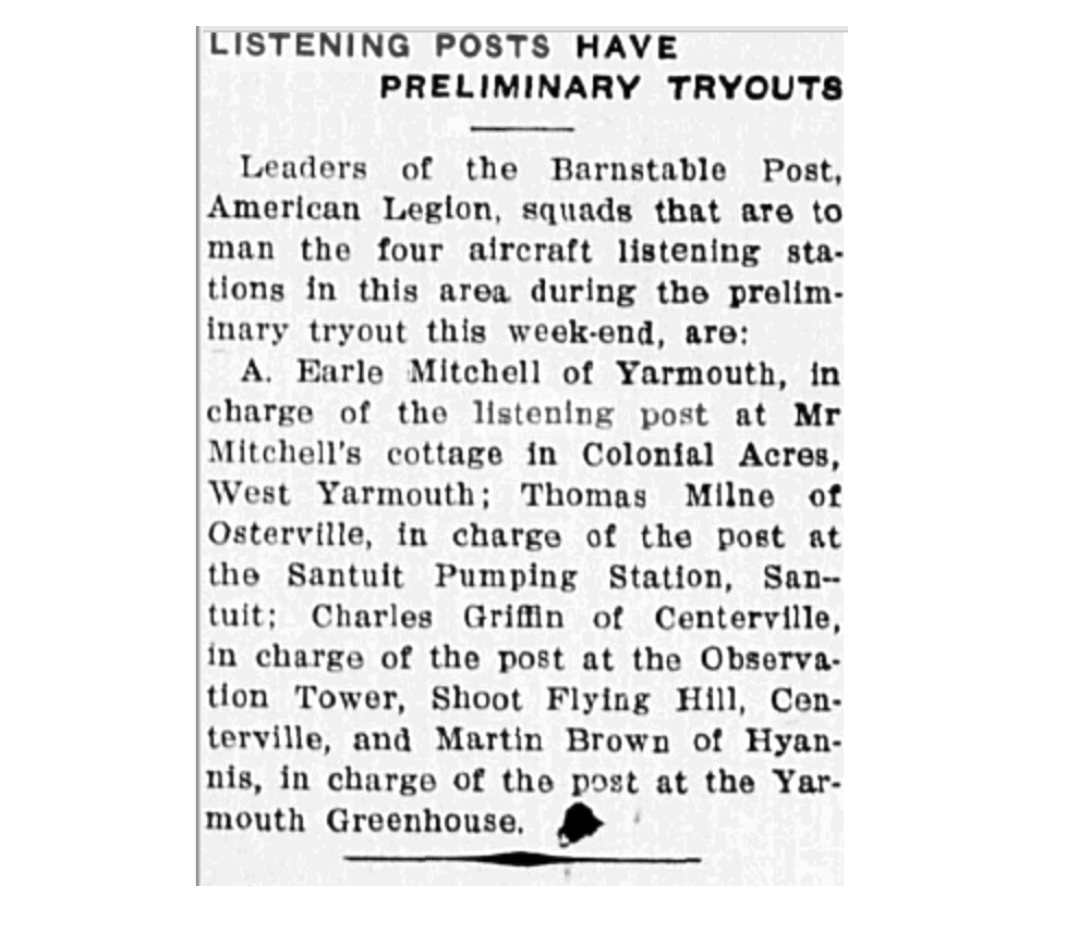In the days before radar and transponders identified aircraft, human eyes and ears had to look for them whenever identity was necessary to protect our shores. Before and during World War II, and again in the 1950s, civilians were asked to serve their country by helping to protect it from attack by air
Of the ten posts organized on Cape Cod, two were located in Yarmouth. These aircraft spotting posts were called the listening posts by the locals. Both listening posts were under the general control of the American Legion Post in Barnstable.
The northern post was located in back of the Green Hill farm which stood at the end of Church Street in Yarmouth Port. At first, the farm’s milk house served as the lookout post. In the winter, observers would duck inside to warm themselves in the steam created by the constantly boiling vat in the center of the room. Later, a building was built further toward the marsh, accessible by a path leading from the farm. The building was a little house, complete with a peaked roof and windows on all four sides so that observers could see in all directions from the inside. There was a small, pot-bellied stove going up through the center of the roof. Observers had to keep it stoked, and sometimes it got very warm inside.
The remains of the Yarmouth Port listening post.
The southern listening post was in West Yarmouth, a little south of what is now Cape Cod Hospital. The building was originally owned by the Holmes family on Bayview Street. It was equipped with a glass cupola to better observe the skies. Roger Allen of Hyannis was the chief observer for both posts.
Each post had a telephone, and observers were asked to phone in any aircraft sighted. Inside the post was a chart to help identify the planes. When a plane was spotted, observers called a filter center with a “flash”. This information was then relayed to a central information center operated by the Army Air Corps. This center was in touch with a fighter interceptor command at all times.
Helen Kelley of Yarmouth Port was appointed to keep all records for the Yarmouth Port Listening Post. One of her major tasks was to see that the listening post was manned 24 hours a day. After 75 hours of service, a person could qualify for an armband from the Army Aircraft Warning Service. Later, observers would receive a pin from the Ground Observer Corps. No volunteers were ever paid for their service.
Obtaining volunteers was constant work. Some volunteers were trained at the Yarmouth Congregational Church where they learned to identify enemy aircraft by silhouettes. Roger Allen usually ran these sessions. The silhouettes of airplanes were made in the school shop in Hyannis under the direction of Theodore Glover. Both Glover and his wife also served as observers at the West Yarmouth listening post.
While adults were the preferred observers, children as young as 14 took their turns in the Yarmouth Port listening post. Pat Kelley Philbrook remembers manning the post with her sister Marcia in two hour blocks. “I can remember my grandfather having to fill in the 4 to 6 AM time slot, before he went to work,” she recalled. “When my mother needed observers, everyone in the family helped out.”
One Christmas proved especially trying for the Kelley family. Not wanting to interfere with other families’ celebrations, the Kelley family manned the listening post the entire Christmas day, celebrating the holiday later only after all of the observing was done.
Leonard Ryder remembered going to the listening post with his mother Genevieve. Being just a young boy, he would usually play outside and sometimes ride the horse on the farm. His grandfather lived at Green Hill farm at the time. Sometimes the cows of the farm were ridden as well. Herman Eldridge remembered rides on the cows while going to and coming from the listening post.
Nellie Thacher and husband Ira manned separate shifts in the Yarmouth Port listening Post, she having early morning hours and her husband had a night shift. When Ruth Kelley served her watches, she took her children Barbara and Edward.
Ira and Nellie Thacher with their children.
Sally Keveney and her friend Mary Hallet got off of the school bus at Church Street to do their stint at the listening post. Sometimes they would hear a plane and not see it but would still call it in. Doing this job made them feel very important and they worried that sometimes they might be reporting erroneous information. Never-the-less, they took the job very seriously and really felt very patriotic.
Boy Scouts took turns as well, living up to the Scout motto of “Duty to Country”. Pat Philbrook’s younger brother was a Boy Scout, and she remembers him pulling his fair share of observation time. Alan Schauwecker also remembered Boy Scouts helping at the listening post. He, along with other scouts Milton Smith and Hack Ellis, put in their fair share of observation time. Dick Philbrook was the scoutmaster of their troop at the time.
“It was a town effort,” Pat Philbrook stated. “Few who were asked declined to volunteer, and those who were busiest still managed to find time.”
The Register, in August 1943, recognized several Yarmouth people for their long hours of service at the listening posts. Included were Phebe Taylor with 172 hours of service, Stephen Bray with 168 hours, Ellen Nickerson with 164, and Fred Schauwecker with 161 hours.
In October, 1943, the listening posts received word that they no longer needed to operate 24 hours a day. From this point on, until they were no longer used, the posts operated only a few hours each day. Finally, on May 16, 1944, the Aircraft Warning Corps and the Ground Observer Corps were discontinued. The war was now in its final offensive phase and the Secretary of War felt that the military personnel and equipment could be better used in other ways during this final year of the war. In a letter to each group he wrote, “You have learned many facts which, if made public, might be of service to the enemy. The War Department looks to you to maintain silence with respect to these matters of national security.”
Although closed down before the war was finally won, by manning the listening post in the Yarmouth marsh, people of all ages added their part to an incredible country-wide war effort.
The threat of the Soviet Union led the United States on July, 12 1952 to restart the Ground Observer Corps as Operation Skywatch. Posts in 27 states were manned 24 hours a day. By 1958, the Ballistic Missile Early Warning System, established by NORAD, was in place, and the GOC was reduced to ready reserve status. A year later, the Ground Observer Corps was inactivated. Technology had finally taken over.
Excerpted from an article by Duncan Oliver and Jack Braginton-Smith






